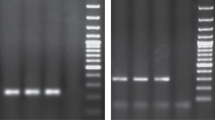Abstract
In the International Union for the Protection of New Varieties of Plants Act of 1991, mutation is mentioned as one of the mechanisms to obtain an ‘essentially derived’ variety (EDV). For the implementation of the EDV concept in the case of mutation, it is important that the level of genetic relatedness between an initial variety and derived mutant varieties can clearly be distinguished from the level of relatedness between arbitrary pairs of varieties without a derivation relation. Conditions to be fulfilled for such a distinction include enough genetic differentiation in the germplasm pool of interest, sufficiently low levels of genomic sampling error and technical laboratory error and high reproducibility within and between laboratories. In rose, mutants or ‘sports’ are frequently observed during multiplication, making it a suitable crop for studying the possibilities for introduction of the EDV concept in ornamentals. We studied genetic similarities among 83 rose varieties, including 13 mutant groups. Twelve AFLP primer combinations generated 284 polymorphic markers and 114 monomorphic (fixed) bands. Pair-wise Jaccard similarities between original varieties and derived mutants were close to 1.0 (>0.96), whereas all similarities between original varieties were below 0.80, with 75% of the non-mutant similarities even being below 0.50. Values less than 1.0 for similarity among original varieties and their mutants were to a major extent due to scoring errors. Error rates in automated scoring proved to be lower than those in manually scored and transferred data. Experimental errors, even between laboratories, turned out to be very small. On the basis of a consistent and large difference between similarities, relations between an original variety and its mutants can easily be identified and distinguished from relations between original varieties. These results open the way for implementing the essential derivation concept in rose.





Similar content being viewed by others
References
Arens P, Coops H, Jansen J, Vosman B (1998) Molecular genetic analysis of Black poplar (Populus nigra L.) along Dutch rivers. Mol Ecol 7:11–18
Borg I, Groenen PJF (1997) Modern multidimensional scaling. Springer, Berlin Heidelberg New York
Bredemeijer GMM, Cooke RJ, Ganal MW, Peeters R, Isaac P, Noordijk Y, Rendell S, Jackson J, Röder MS, Wendehake K, Dijcks M, Amelaine M, Wickaert R, Bertrand L, Vosman B (2002) Construction and testing of a microsatellite database containing more than 500 tomato varieties. Theor Appl Genet 105:1019–1026
Cairns T (2000) Modern roses XI, the world encyclopedia of roses. Academic, New York
Debener T, Bartels C, Mattiesch L (1996) RAPD analysis of genetic variation between a group of rose cultivars and selected wild rose species. Mol Breed 2:321–327
Debener T, Janakiram T, Mattiesch L (2000) Sports and seedlings of rose varieties analysed with molecular markers. Plant Breed 119:71–74
De Riek J, Dendauw J, Leus L, De Loose M, Van Bockstaele E (2001) Variety protection by use of molecular markers: some case studies on ornamentals. Plant Biosyst 135:107–113
Digby PGN, Kempton RA (1987) Multivariate analysis of ecological communities. Chapman and Hall, London
Esselink GD, Smulders MJM, Vosman B (2003) Identification of cut rose (Rosa hybrida) and rootstock varieties using robust sequence tagged microsatellite markers. Theor Appl Genet 106:277–286
Heckenberger M, Bohn M, Ziegle JS, Joe LK, Hauser JD, Hutton M, Melchinger AE (2002) Variation of DNA fingerprints among accessions within maize inbred lines and implications for identification of essentially derived varieties. I. Genetic and technical sources of variation in SSR data. Mol Breed 10:181–191
Jones CJ, Edwards KJ, Castiglione S, Winfield MO, Sala F, Van de Wiel C, Bredemeijer G, Vosman B, Matthes M, Daly A, Brettschneider R, Bettini P, Buiatti M, Maestri E, Malcevschi A, Marmiroli N, Aert R, Volckaert G, Rueda J, Linacero R, Vazquez A, Karp A (1997) Reproducibility testing of RAPD, AFLP and SSR markers in plants by a network of European laboratories. Mol Breed 3:381–390
Nuel G, Baril C, Robin S (2001) Varietal distinctness assisted by molecular markers: A methodological approach. Acta Hortic 546:65–71
Röder MS, Wendehake K, Korzun V, Bredemeijer G, Laborie D, Bertrand L, Isaac P, Rendell S, Jackson J, Cooke RJ, Vosman B, Ganal MW (2002) Construction and analysis of a microsatellite-based database of European wheat varieties. Theor Appl Genet 106:67–73
Van Eeuwijk FA, Baril CP (2001) Conceptual and statistical issues related to the use of molecular markers for distinctness and essential derivation. Acta Hortic 546:35–53
Van Eeuwijk FA, Law JR (2004) Statistical aspects of essential derivation, with illustrations based on lettuce and barley. Euphytica 137:129–137
Steward CN, Via LE (1993) A rapid CTAB DNA isolation technique useful for RAPD fingerprinting and other PCR applications. Biotechniques 14:748–750
UPOV (1991) International convention for the protection of new varieties of plants. UPOV, Geneva, publication 221(E)
Vos P, Hogers R, Bleeker M, Reijans M, van de Lee T, Hornes M, Frijters A, Pot J, Peleman J, Kuiper M, Zabeau M (1995) AFLP: a new technique for DNA fingerprinting. Nucleic Acids Res 23:4407–4414
Acknowledgements
The authors acknowledge the financial support of the European Commission (QLRT-1999-PL1499) and the Ministry of Agriculture, Nature and Food safety of the Netherlands. Breeding companies (Meilland, de Ruiter, Schreurs, Tantau, Prego, Interplant, Spek, Kordes and Rosaflor) are acknowledged for providing the material.
Author information
Authors and Affiliations
Corresponding author
Additional information
Communicated by H. Nybom
Rights and permissions
About this article
Cite this article
Vosman, B., Visser, D., van der Voort, J.R. et al. The establishment of ‘essential derivation’ among rose varieties, using AFLP. Theor Appl Genet 109, 1718–1725 (2004). https://doi.org/10.1007/s00122-004-1809-3
Received:
Accepted:
Published:
Issue Date:
DOI: https://doi.org/10.1007/s00122-004-1809-3




